Child and Adolescent Nursing: Pathophysiology, Growth and Developmental Theories, Family-Centered Care, and Effects of Hospitalization
VerifiedAdded on 2023/06/09
|10
|2932
|163
AI Summary
This article discusses child and adolescent nursing, including pathophysiology, growth and developmental theories, family-centered care, and effects of hospitalization. It also includes a case study of a 10-year-old girl with appendicitis.
Contribute Materials
Your contribution can guide someone’s learning journey. Share your
documents today.
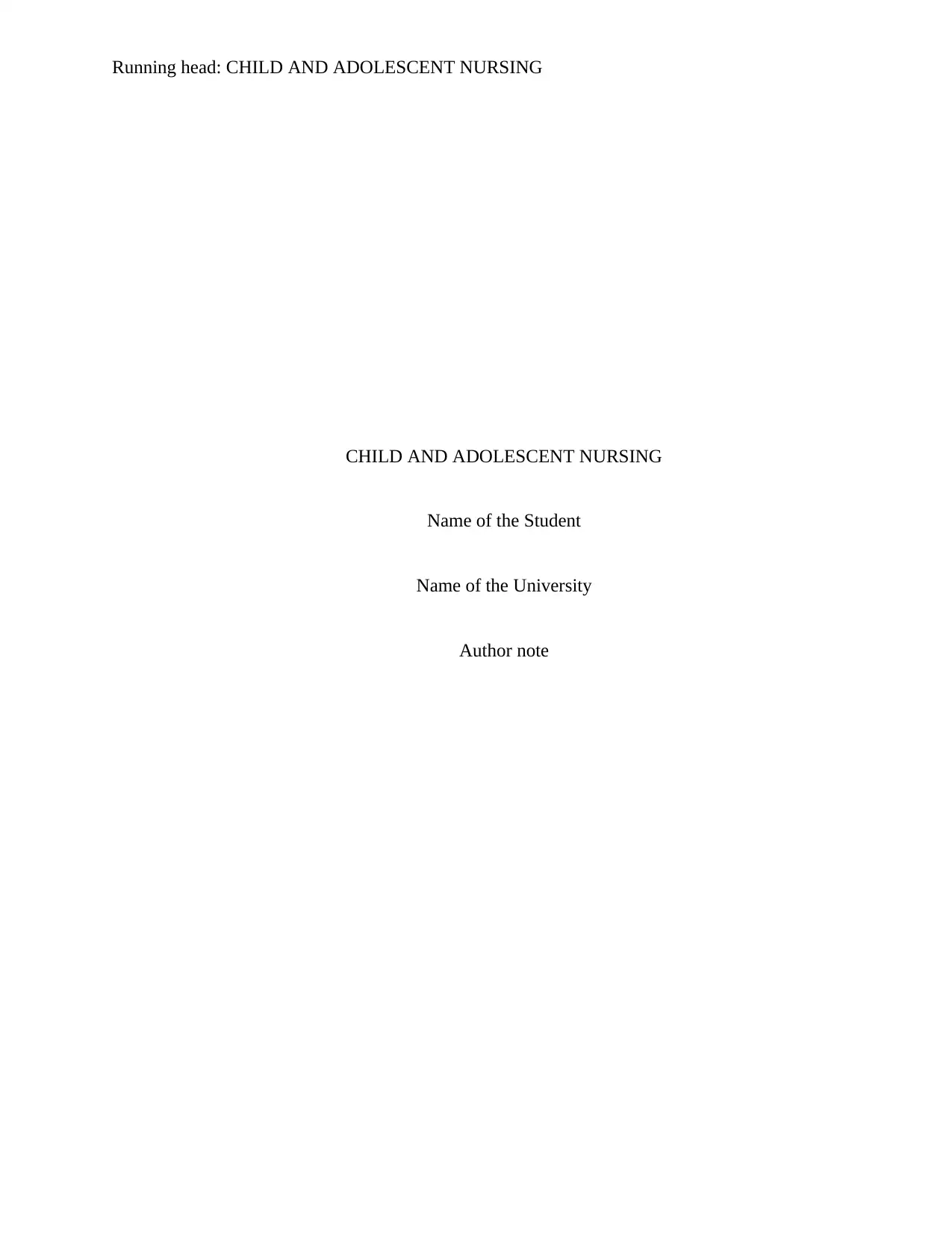
Running head: CHILD AND ADOLESCENT NURSING
CHILD AND ADOLESCENT NURSING
Name of the Student
Name of the University
Author note
CHILD AND ADOLESCENT NURSING
Name of the Student
Name of the University
Author note
Secure Best Marks with AI Grader
Need help grading? Try our AI Grader for instant feedback on your assignments.

1CHILD AND ADOLESCENT NURSING
Introduction
In nursing profession, child and nursing care involve care for a sick newborn to an
adolescent to make him recover from any road accident (Cockcroft, 2012). These professional
work as a part of multidisciplinary teams and their key roles include assessing and planning the
requirements involved in childcare unit, dealing with emergencies, supervising junior staff,
organizing workload and preparing notes of the events (Shields et al., 2012). In this assignment
discussion about Anne (10) whose signs and symptoms have been recognized as appendicitis has
been informed. Further, after describing the pathophysiology of presented problem, evaluation of
the nurse's role in delivering the appropriate nursing care in relation to Anne’s case study will be
described with growth and developmental theories, family-centered care and the effect of
hospitalization on the child will be mentioned in this assignment.
Pathophysiology
The appendix is a finger-shaped pouch present in the lower right side of the abdomen and
inflammation of this pouch is called as appendicitis. As per Singal et al. (2012) there is no
specific role of this vestigial organ in the human body, however, the presence of lymphatic tissue
imparts in the immune system. As per Bhangu et al. (2015) the emergence of appendicitis in
teenage or young adults determines due to the pathophysiological role of different lymphoid
aggregates, which is present in a huge amount in the appendix during this period. Therefore, as
per this theory of Chandrasegaram et al. (2012), such obstruction commences inflammatory
changes in the surrounding tissue which eventually rises the intraluminal pressure and ischemia
(Singal et al., 2012). Further, the inflammation in the appendix makes it enlarged and the
surrounding tissues such as peritoneum and percicecal fat becomes inflammatory. The primary
Introduction
In nursing profession, child and nursing care involve care for a sick newborn to an
adolescent to make him recover from any road accident (Cockcroft, 2012). These professional
work as a part of multidisciplinary teams and their key roles include assessing and planning the
requirements involved in childcare unit, dealing with emergencies, supervising junior staff,
organizing workload and preparing notes of the events (Shields et al., 2012). In this assignment
discussion about Anne (10) whose signs and symptoms have been recognized as appendicitis has
been informed. Further, after describing the pathophysiology of presented problem, evaluation of
the nurse's role in delivering the appropriate nursing care in relation to Anne’s case study will be
described with growth and developmental theories, family-centered care and the effect of
hospitalization on the child will be mentioned in this assignment.
Pathophysiology
The appendix is a finger-shaped pouch present in the lower right side of the abdomen and
inflammation of this pouch is called as appendicitis. As per Singal et al. (2012) there is no
specific role of this vestigial organ in the human body, however, the presence of lymphatic tissue
imparts in the immune system. As per Bhangu et al. (2015) the emergence of appendicitis in
teenage or young adults determines due to the pathophysiological role of different lymphoid
aggregates, which is present in a huge amount in the appendix during this period. Therefore, as
per this theory of Chandrasegaram et al. (2012), such obstruction commences inflammatory
changes in the surrounding tissue which eventually rises the intraluminal pressure and ischemia
(Singal et al., 2012). Further, the inflammation in the appendix makes it enlarged and the
surrounding tissues such as peritoneum and percicecal fat becomes inflammatory. The primary
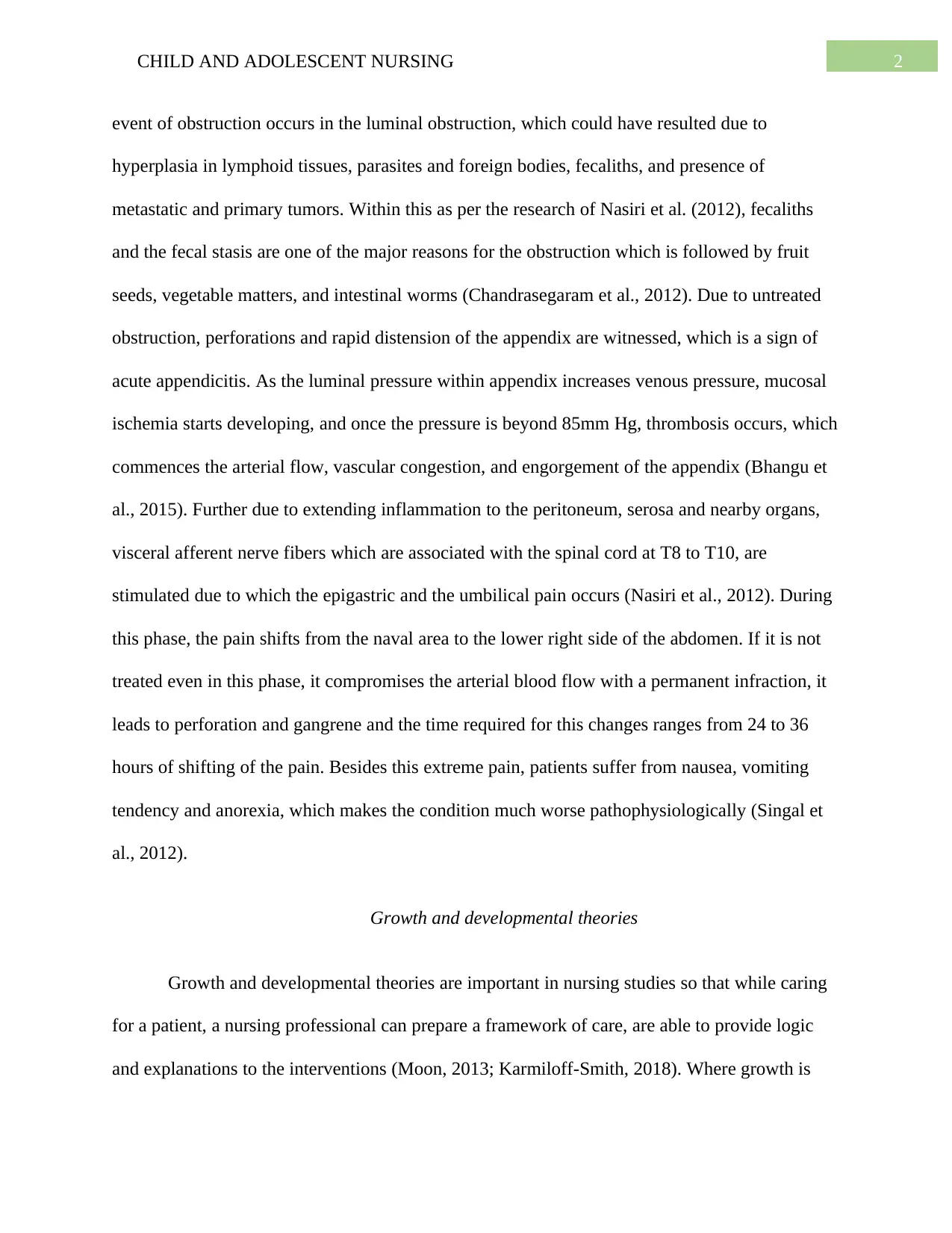
2CHILD AND ADOLESCENT NURSING
event of obstruction occurs in the luminal obstruction, which could have resulted due to
hyperplasia in lymphoid tissues, parasites and foreign bodies, fecaliths, and presence of
metastatic and primary tumors. Within this as per the research of Nasiri et al. (2012), fecaliths
and the fecal stasis are one of the major reasons for the obstruction which is followed by fruit
seeds, vegetable matters, and intestinal worms (Chandrasegaram et al., 2012). Due to untreated
obstruction, perforations and rapid distension of the appendix are witnessed, which is a sign of
acute appendicitis. As the luminal pressure within appendix increases venous pressure, mucosal
ischemia starts developing, and once the pressure is beyond 85mm Hg, thrombosis occurs, which
commences the arterial flow, vascular congestion, and engorgement of the appendix (Bhangu et
al., 2015). Further due to extending inflammation to the peritoneum, serosa and nearby organs,
visceral afferent nerve fibers which are associated with the spinal cord at T8 to T10, are
stimulated due to which the epigastric and the umbilical pain occurs (Nasiri et al., 2012). During
this phase, the pain shifts from the naval area to the lower right side of the abdomen. If it is not
treated even in this phase, it compromises the arterial blood flow with a permanent infraction, it
leads to perforation and gangrene and the time required for this changes ranges from 24 to 36
hours of shifting of the pain. Besides this extreme pain, patients suffer from nausea, vomiting
tendency and anorexia, which makes the condition much worse pathophysiologically (Singal et
al., 2012).
Growth and developmental theories
Growth and developmental theories are important in nursing studies so that while caring
for a patient, a nursing professional can prepare a framework of care, are able to provide logic
and explanations to the interventions (Moon, 2013; Karmiloff-Smith, 2018). Where growth is
event of obstruction occurs in the luminal obstruction, which could have resulted due to
hyperplasia in lymphoid tissues, parasites and foreign bodies, fecaliths, and presence of
metastatic and primary tumors. Within this as per the research of Nasiri et al. (2012), fecaliths
and the fecal stasis are one of the major reasons for the obstruction which is followed by fruit
seeds, vegetable matters, and intestinal worms (Chandrasegaram et al., 2012). Due to untreated
obstruction, perforations and rapid distension of the appendix are witnessed, which is a sign of
acute appendicitis. As the luminal pressure within appendix increases venous pressure, mucosal
ischemia starts developing, and once the pressure is beyond 85mm Hg, thrombosis occurs, which
commences the arterial flow, vascular congestion, and engorgement of the appendix (Bhangu et
al., 2015). Further due to extending inflammation to the peritoneum, serosa and nearby organs,
visceral afferent nerve fibers which are associated with the spinal cord at T8 to T10, are
stimulated due to which the epigastric and the umbilical pain occurs (Nasiri et al., 2012). During
this phase, the pain shifts from the naval area to the lower right side of the abdomen. If it is not
treated even in this phase, it compromises the arterial blood flow with a permanent infraction, it
leads to perforation and gangrene and the time required for this changes ranges from 24 to 36
hours of shifting of the pain. Besides this extreme pain, patients suffer from nausea, vomiting
tendency and anorexia, which makes the condition much worse pathophysiologically (Singal et
al., 2012).
Growth and developmental theories
Growth and developmental theories are important in nursing studies so that while caring
for a patient, a nursing professional can prepare a framework of care, are able to provide logic
and explanations to the interventions (Moon, 2013; Karmiloff-Smith, 2018). Where growth is
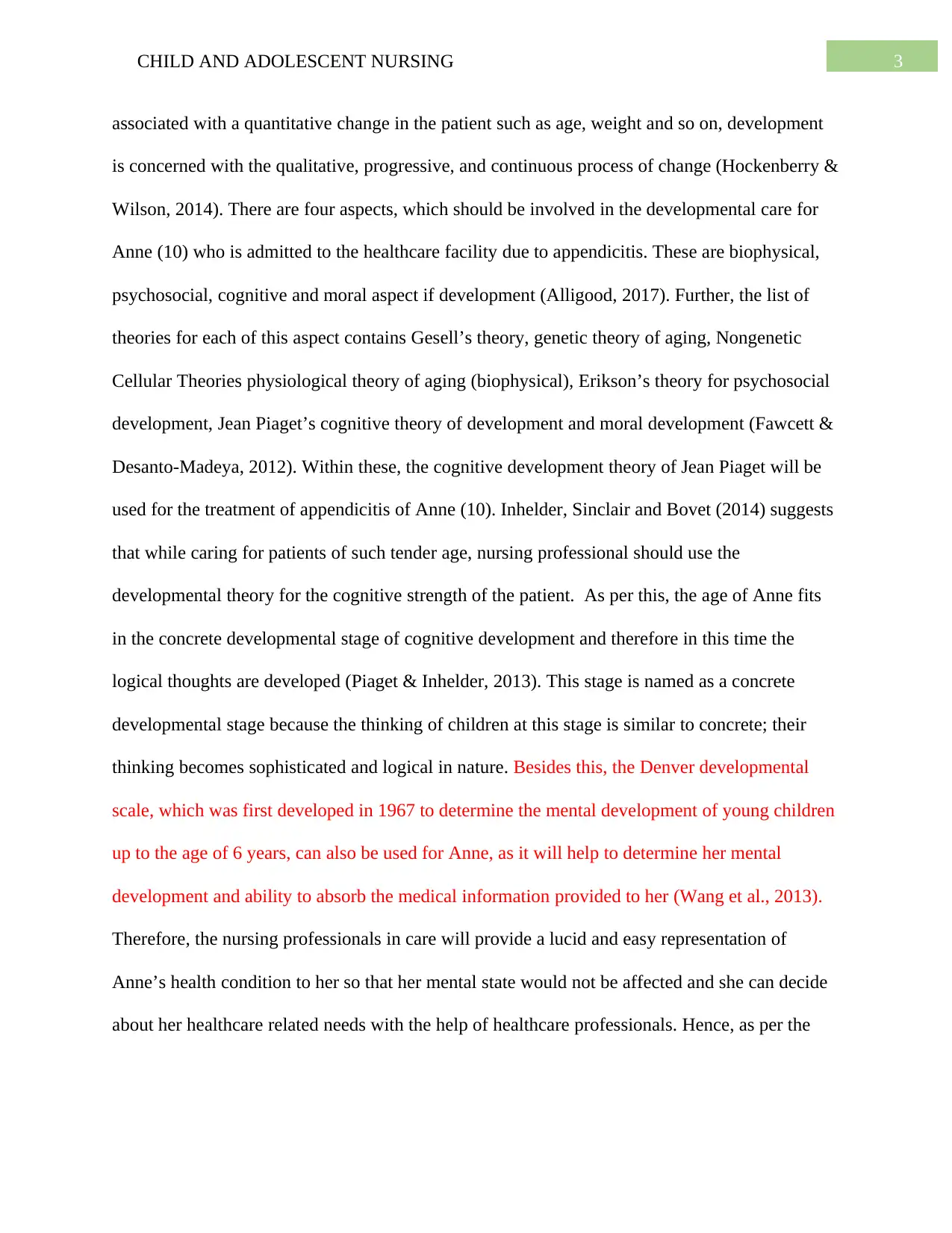
3CHILD AND ADOLESCENT NURSING
associated with a quantitative change in the patient such as age, weight and so on, development
is concerned with the qualitative, progressive, and continuous process of change (Hockenberry &
Wilson, 2014). There are four aspects, which should be involved in the developmental care for
Anne (10) who is admitted to the healthcare facility due to appendicitis. These are biophysical,
psychosocial, cognitive and moral aspect if development (Alligood, 2017). Further, the list of
theories for each of this aspect contains Gesell’s theory, genetic theory of aging, Nongenetic
Cellular Theories physiological theory of aging (biophysical), Erikson’s theory for psychosocial
development, Jean Piaget’s cognitive theory of development and moral development (Fawcett &
Desanto-Madeya, 2012). Within these, the cognitive development theory of Jean Piaget will be
used for the treatment of appendicitis of Anne (10). Inhelder, Sinclair and Bovet (2014) suggests
that while caring for patients of such tender age, nursing professional should use the
developmental theory for the cognitive strength of the patient. As per this, the age of Anne fits
in the concrete developmental stage of cognitive development and therefore in this time the
logical thoughts are developed (Piaget & Inhelder, 2013). This stage is named as a concrete
developmental stage because the thinking of children at this stage is similar to concrete; their
thinking becomes sophisticated and logical in nature. Besides this, the Denver developmental
scale, which was first developed in 1967 to determine the mental development of young children
up to the age of 6 years, can also be used for Anne, as it will help to determine her mental
development and ability to absorb the medical information provided to her (Wang et al., 2013).
Therefore, the nursing professionals in care will provide a lucid and easy representation of
Anne’s health condition to her so that her mental state would not be affected and she can decide
about her healthcare related needs with the help of healthcare professionals. Hence, as per the
associated with a quantitative change in the patient such as age, weight and so on, development
is concerned with the qualitative, progressive, and continuous process of change (Hockenberry &
Wilson, 2014). There are four aspects, which should be involved in the developmental care for
Anne (10) who is admitted to the healthcare facility due to appendicitis. These are biophysical,
psychosocial, cognitive and moral aspect if development (Alligood, 2017). Further, the list of
theories for each of this aspect contains Gesell’s theory, genetic theory of aging, Nongenetic
Cellular Theories physiological theory of aging (biophysical), Erikson’s theory for psychosocial
development, Jean Piaget’s cognitive theory of development and moral development (Fawcett &
Desanto-Madeya, 2012). Within these, the cognitive development theory of Jean Piaget will be
used for the treatment of appendicitis of Anne (10). Inhelder, Sinclair and Bovet (2014) suggests
that while caring for patients of such tender age, nursing professional should use the
developmental theory for the cognitive strength of the patient. As per this, the age of Anne fits
in the concrete developmental stage of cognitive development and therefore in this time the
logical thoughts are developed (Piaget & Inhelder, 2013). This stage is named as a concrete
developmental stage because the thinking of children at this stage is similar to concrete; their
thinking becomes sophisticated and logical in nature. Besides this, the Denver developmental
scale, which was first developed in 1967 to determine the mental development of young children
up to the age of 6 years, can also be used for Anne, as it will help to determine her mental
development and ability to absorb the medical information provided to her (Wang et al., 2013).
Therefore, the nursing professionals in care will provide a lucid and easy representation of
Anne’s health condition to her so that her mental state would not be affected and she can decide
about her healthcare related needs with the help of healthcare professionals. Hence, as per the
Paraphrase This Document
Need a fresh take? Get an instant paraphrase of this document with our AI Paraphraser
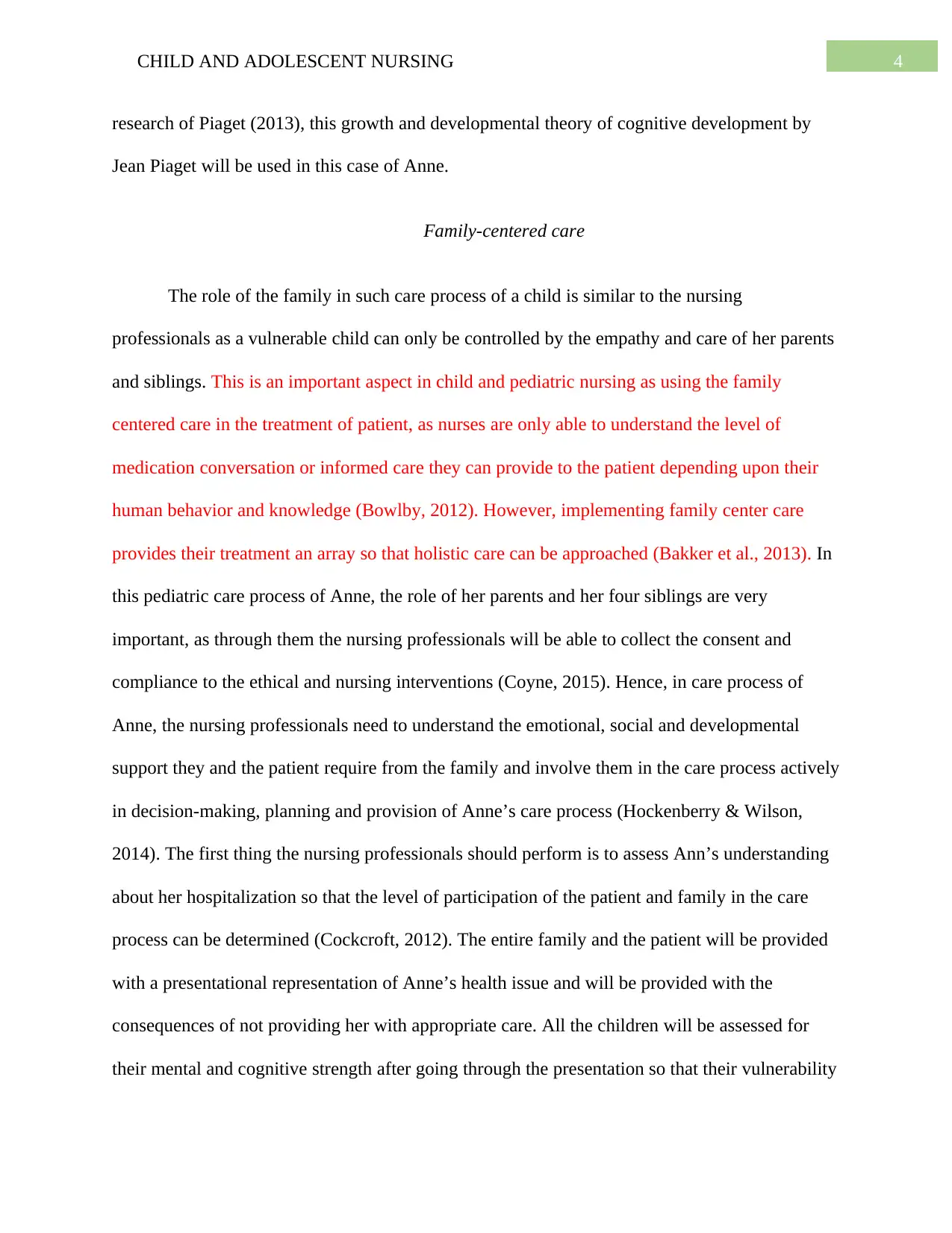
4CHILD AND ADOLESCENT NURSING
research of Piaget (2013), this growth and developmental theory of cognitive development by
Jean Piaget will be used in this case of Anne.
Family-centered care
The role of the family in such care process of a child is similar to the nursing
professionals as a vulnerable child can only be controlled by the empathy and care of her parents
and siblings. This is an important aspect in child and pediatric nursing as using the family
centered care in the treatment of patient, as nurses are only able to understand the level of
medication conversation or informed care they can provide to the patient depending upon their
human behavior and knowledge (Bowlby, 2012). However, implementing family center care
provides their treatment an array so that holistic care can be approached (Bakker et al., 2013). In
this pediatric care process of Anne, the role of her parents and her four siblings are very
important, as through them the nursing professionals will be able to collect the consent and
compliance to the ethical and nursing interventions (Coyne, 2015). Hence, in care process of
Anne, the nursing professionals need to understand the emotional, social and developmental
support they and the patient require from the family and involve them in the care process actively
in decision-making, planning and provision of Anne’s care process (Hockenberry & Wilson,
2014). The first thing the nursing professionals should perform is to assess Ann’s understanding
about her hospitalization so that the level of participation of the patient and family in the care
process can be determined (Cockcroft, 2012). The entire family and the patient will be provided
with a presentational representation of Anne’s health issue and will be provided with the
consequences of not providing her with appropriate care. All the children will be assessed for
their mental and cognitive strength after going through the presentation so that their vulnerability
research of Piaget (2013), this growth and developmental theory of cognitive development by
Jean Piaget will be used in this case of Anne.
Family-centered care
The role of the family in such care process of a child is similar to the nursing
professionals as a vulnerable child can only be controlled by the empathy and care of her parents
and siblings. This is an important aspect in child and pediatric nursing as using the family
centered care in the treatment of patient, as nurses are only able to understand the level of
medication conversation or informed care they can provide to the patient depending upon their
human behavior and knowledge (Bowlby, 2012). However, implementing family center care
provides their treatment an array so that holistic care can be approached (Bakker et al., 2013). In
this pediatric care process of Anne, the role of her parents and her four siblings are very
important, as through them the nursing professionals will be able to collect the consent and
compliance to the ethical and nursing interventions (Coyne, 2015). Hence, in care process of
Anne, the nursing professionals need to understand the emotional, social and developmental
support they and the patient require from the family and involve them in the care process actively
in decision-making, planning and provision of Anne’s care process (Hockenberry & Wilson,
2014). The first thing the nursing professionals should perform is to assess Ann’s understanding
about her hospitalization so that the level of participation of the patient and family in the care
process can be determined (Cockcroft, 2012). The entire family and the patient will be provided
with a presentational representation of Anne’s health issue and will be provided with the
consequences of not providing her with appropriate care. All the children will be assessed for
their mental and cognitive strength after going through the presentation so that their vulnerability
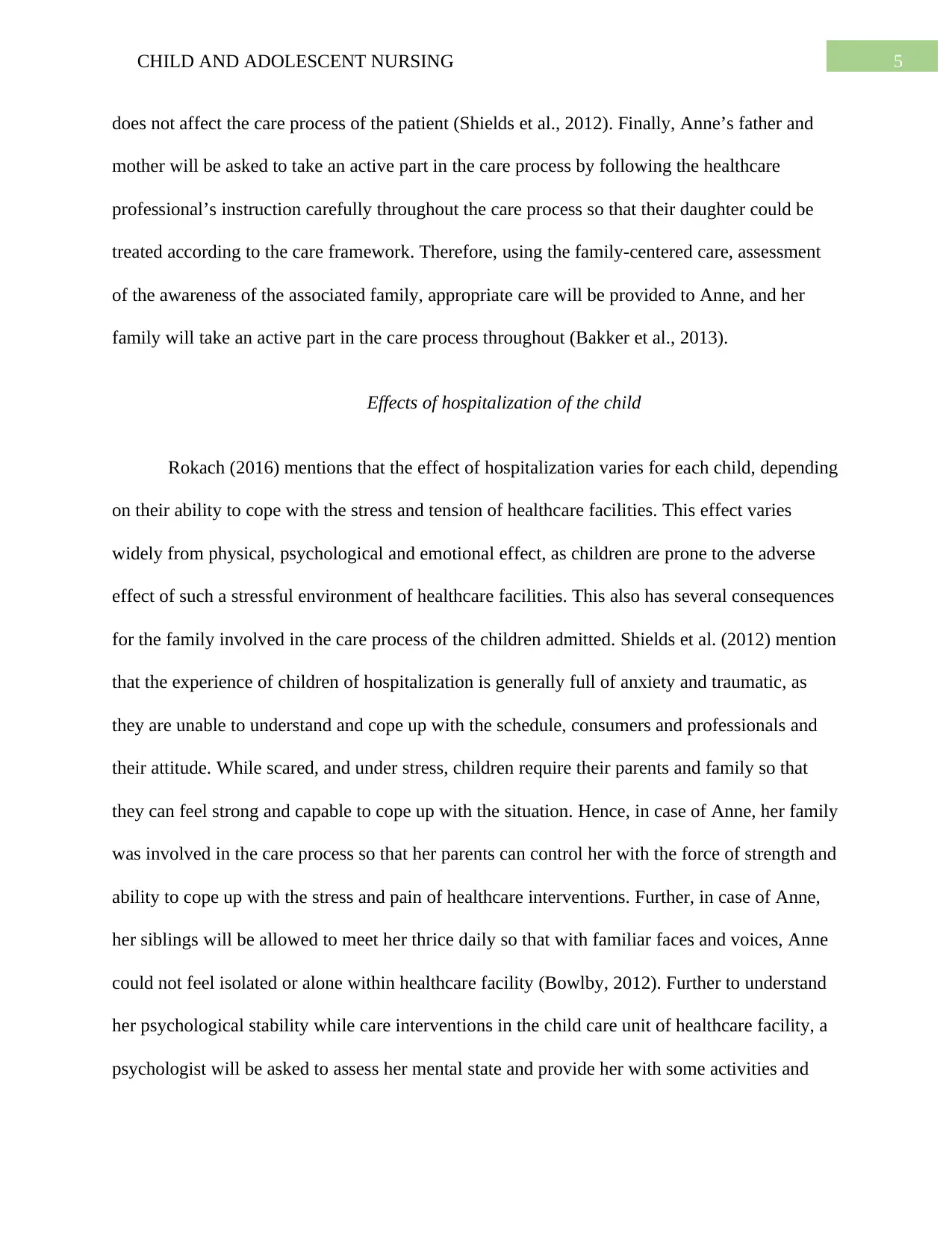
5CHILD AND ADOLESCENT NURSING
does not affect the care process of the patient (Shields et al., 2012). Finally, Anne’s father and
mother will be asked to take an active part in the care process by following the healthcare
professional’s instruction carefully throughout the care process so that their daughter could be
treated according to the care framework. Therefore, using the family-centered care, assessment
of the awareness of the associated family, appropriate care will be provided to Anne, and her
family will take an active part in the care process throughout (Bakker et al., 2013).
Effects of hospitalization of the child
Rokach (2016) mentions that the effect of hospitalization varies for each child, depending
on their ability to cope with the stress and tension of healthcare facilities. This effect varies
widely from physical, psychological and emotional effect, as children are prone to the adverse
effect of such a stressful environment of healthcare facilities. This also has several consequences
for the family involved in the care process of the children admitted. Shields et al. (2012) mention
that the experience of children of hospitalization is generally full of anxiety and traumatic, as
they are unable to understand and cope up with the schedule, consumers and professionals and
their attitude. While scared, and under stress, children require their parents and family so that
they can feel strong and capable to cope up with the situation. Hence, in case of Anne, her family
was involved in the care process so that her parents can control her with the force of strength and
ability to cope up with the stress and pain of healthcare interventions. Further, in case of Anne,
her siblings will be allowed to meet her thrice daily so that with familiar faces and voices, Anne
could not feel isolated or alone within healthcare facility (Bowlby, 2012). Further to understand
her psychological stability while care interventions in the child care unit of healthcare facility, a
psychologist will be asked to assess her mental state and provide her with some activities and
does not affect the care process of the patient (Shields et al., 2012). Finally, Anne’s father and
mother will be asked to take an active part in the care process by following the healthcare
professional’s instruction carefully throughout the care process so that their daughter could be
treated according to the care framework. Therefore, using the family-centered care, assessment
of the awareness of the associated family, appropriate care will be provided to Anne, and her
family will take an active part in the care process throughout (Bakker et al., 2013).
Effects of hospitalization of the child
Rokach (2016) mentions that the effect of hospitalization varies for each child, depending
on their ability to cope with the stress and tension of healthcare facilities. This effect varies
widely from physical, psychological and emotional effect, as children are prone to the adverse
effect of such a stressful environment of healthcare facilities. This also has several consequences
for the family involved in the care process of the children admitted. Shields et al. (2012) mention
that the experience of children of hospitalization is generally full of anxiety and traumatic, as
they are unable to understand and cope up with the schedule, consumers and professionals and
their attitude. While scared, and under stress, children require their parents and family so that
they can feel strong and capable to cope up with the situation. Hence, in case of Anne, her family
was involved in the care process so that her parents can control her with the force of strength and
ability to cope up with the stress and pain of healthcare interventions. Further, in case of Anne,
her siblings will be allowed to meet her thrice daily so that with familiar faces and voices, Anne
could not feel isolated or alone within healthcare facility (Bowlby, 2012). Further to understand
her psychological stability while care interventions in the child care unit of healthcare facility, a
psychologist will be asked to assess her mental state and provide her with some activities and
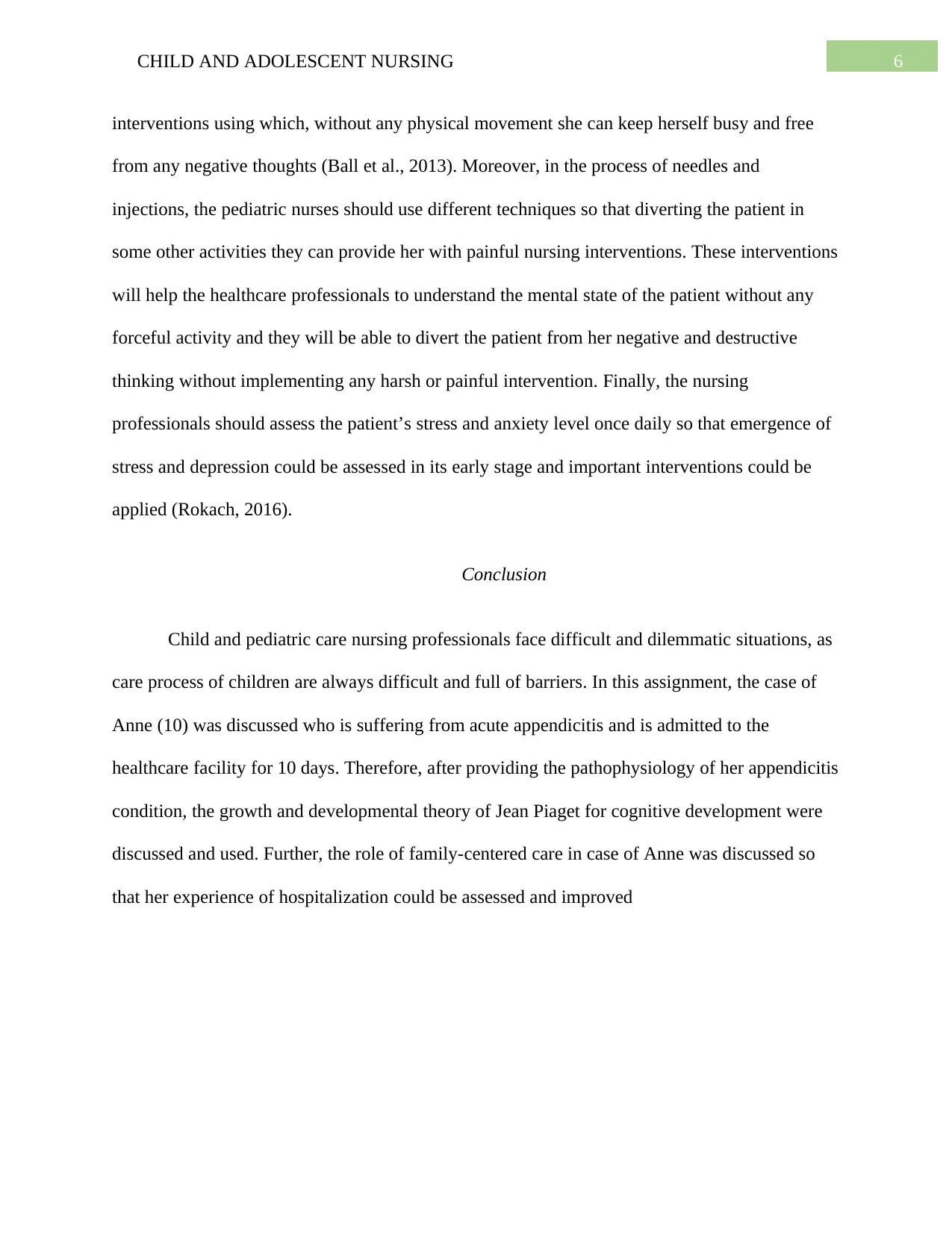
6CHILD AND ADOLESCENT NURSING
interventions using which, without any physical movement she can keep herself busy and free
from any negative thoughts (Ball et al., 2013). Moreover, in the process of needles and
injections, the pediatric nurses should use different techniques so that diverting the patient in
some other activities they can provide her with painful nursing interventions. These interventions
will help the healthcare professionals to understand the mental state of the patient without any
forceful activity and they will be able to divert the patient from her negative and destructive
thinking without implementing any harsh or painful intervention. Finally, the nursing
professionals should assess the patient’s stress and anxiety level once daily so that emergence of
stress and depression could be assessed in its early stage and important interventions could be
applied (Rokach, 2016).
Conclusion
Child and pediatric care nursing professionals face difficult and dilemmatic situations, as
care process of children are always difficult and full of barriers. In this assignment, the case of
Anne (10) was discussed who is suffering from acute appendicitis and is admitted to the
healthcare facility for 10 days. Therefore, after providing the pathophysiology of her appendicitis
condition, the growth and developmental theory of Jean Piaget for cognitive development were
discussed and used. Further, the role of family-centered care in case of Anne was discussed so
that her experience of hospitalization could be assessed and improved
interventions using which, without any physical movement she can keep herself busy and free
from any negative thoughts (Ball et al., 2013). Moreover, in the process of needles and
injections, the pediatric nurses should use different techniques so that diverting the patient in
some other activities they can provide her with painful nursing interventions. These interventions
will help the healthcare professionals to understand the mental state of the patient without any
forceful activity and they will be able to divert the patient from her negative and destructive
thinking without implementing any harsh or painful intervention. Finally, the nursing
professionals should assess the patient’s stress and anxiety level once daily so that emergence of
stress and depression could be assessed in its early stage and important interventions could be
applied (Rokach, 2016).
Conclusion
Child and pediatric care nursing professionals face difficult and dilemmatic situations, as
care process of children are always difficult and full of barriers. In this assignment, the case of
Anne (10) was discussed who is suffering from acute appendicitis and is admitted to the
healthcare facility for 10 days. Therefore, after providing the pathophysiology of her appendicitis
condition, the growth and developmental theory of Jean Piaget for cognitive development were
discussed and used. Further, the role of family-centered care in case of Anne was discussed so
that her experience of hospitalization could be assessed and improved
Secure Best Marks with AI Grader
Need help grading? Try our AI Grader for instant feedback on your assignments.
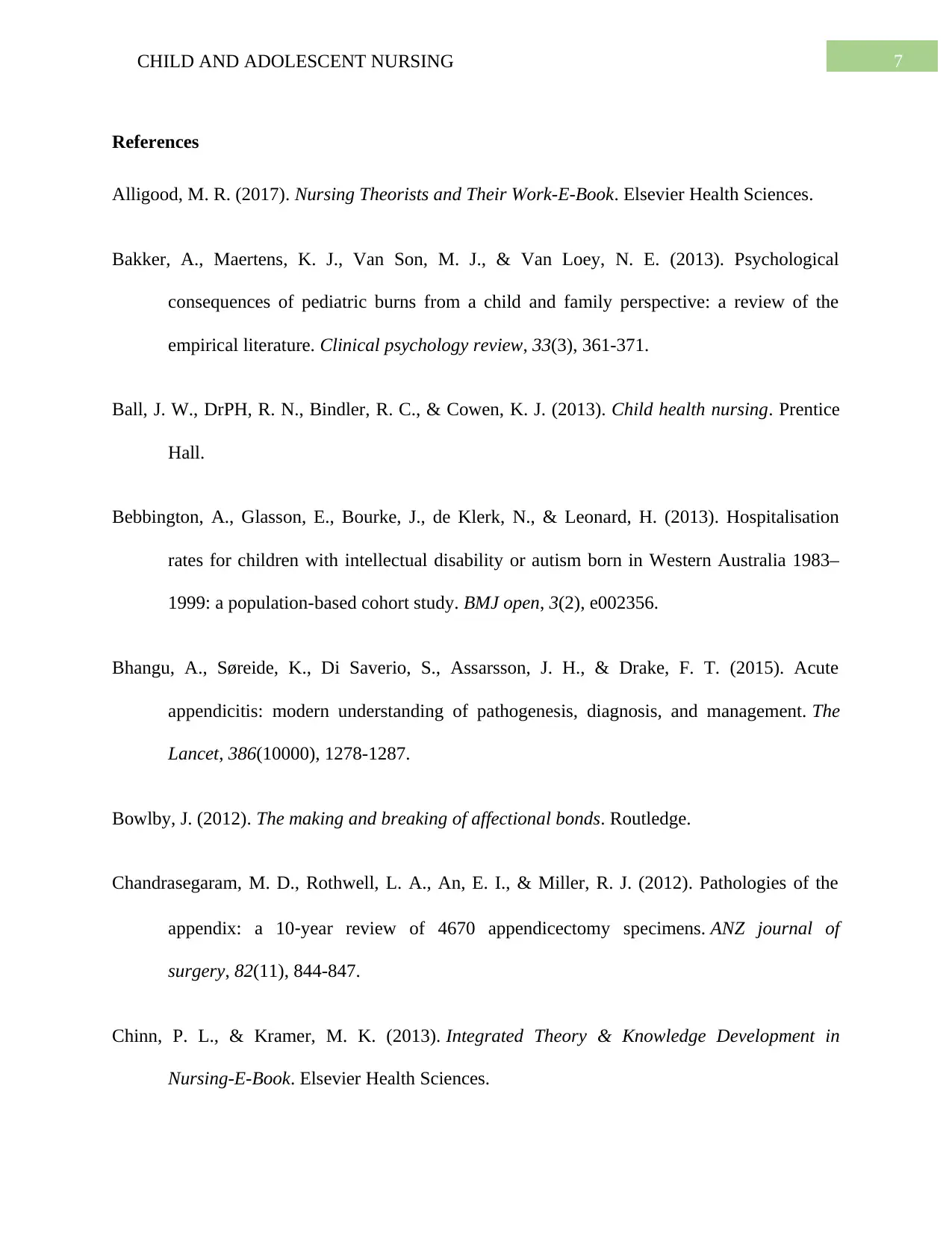
7CHILD AND ADOLESCENT NURSING
References
Alligood, M. R. (2017). Nursing Theorists and Their Work-E-Book. Elsevier Health Sciences.
Bakker, A., Maertens, K. J., Van Son, M. J., & Van Loey, N. E. (2013). Psychological
consequences of pediatric burns from a child and family perspective: a review of the
empirical literature. Clinical psychology review, 33(3), 361-371.
Ball, J. W., DrPH, R. N., Bindler, R. C., & Cowen, K. J. (2013). Child health nursing. Prentice
Hall.
Bebbington, A., Glasson, E., Bourke, J., de Klerk, N., & Leonard, H. (2013). Hospitalisation
rates for children with intellectual disability or autism born in Western Australia 1983–
1999: a population-based cohort study. BMJ open, 3(2), e002356.
Bhangu, A., Søreide, K., Di Saverio, S., Assarsson, J. H., & Drake, F. T. (2015). Acute
appendicitis: modern understanding of pathogenesis, diagnosis, and management. The
Lancet, 386(10000), 1278-1287.
Bowlby, J. (2012). The making and breaking of affectional bonds. Routledge.
Chandrasegaram, M. D., Rothwell, L. A., An, E. I., & Miller, R. J. (2012). Pathologies of the
appendix: a 10‐year review of 4670 appendicectomy specimens. ANZ journal of
surgery, 82(11), 844-847.
Chinn, P. L., & Kramer, M. K. (2013). Integrated Theory & Knowledge Development in
Nursing-E-Book. Elsevier Health Sciences.
References
Alligood, M. R. (2017). Nursing Theorists and Their Work-E-Book. Elsevier Health Sciences.
Bakker, A., Maertens, K. J., Van Son, M. J., & Van Loey, N. E. (2013). Psychological
consequences of pediatric burns from a child and family perspective: a review of the
empirical literature. Clinical psychology review, 33(3), 361-371.
Ball, J. W., DrPH, R. N., Bindler, R. C., & Cowen, K. J. (2013). Child health nursing. Prentice
Hall.
Bebbington, A., Glasson, E., Bourke, J., de Klerk, N., & Leonard, H. (2013). Hospitalisation
rates for children with intellectual disability or autism born in Western Australia 1983–
1999: a population-based cohort study. BMJ open, 3(2), e002356.
Bhangu, A., Søreide, K., Di Saverio, S., Assarsson, J. H., & Drake, F. T. (2015). Acute
appendicitis: modern understanding of pathogenesis, diagnosis, and management. The
Lancet, 386(10000), 1278-1287.
Bowlby, J. (2012). The making and breaking of affectional bonds. Routledge.
Chandrasegaram, M. D., Rothwell, L. A., An, E. I., & Miller, R. J. (2012). Pathologies of the
appendix: a 10‐year review of 4670 appendicectomy specimens. ANZ journal of
surgery, 82(11), 844-847.
Chinn, P. L., & Kramer, M. K. (2013). Integrated Theory & Knowledge Development in
Nursing-E-Book. Elsevier Health Sciences.
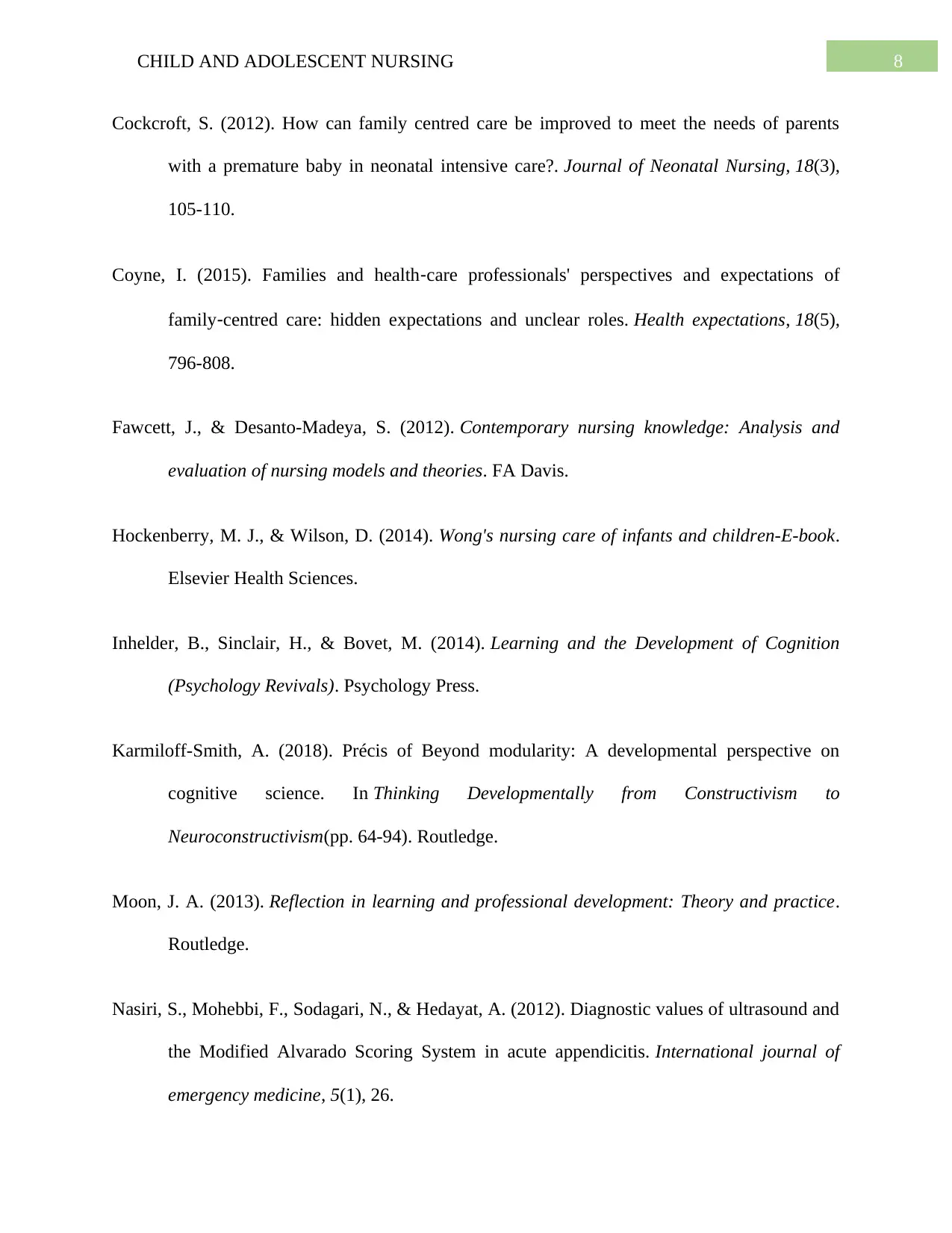
8CHILD AND ADOLESCENT NURSING
Cockcroft, S. (2012). How can family centred care be improved to meet the needs of parents
with a premature baby in neonatal intensive care?. Journal of Neonatal Nursing, 18(3),
105-110.
Coyne, I. (2015). Families and health‐care professionals' perspectives and expectations of
family‐centred care: hidden expectations and unclear roles. Health expectations, 18(5),
796-808.
Fawcett, J., & Desanto-Madeya, S. (2012). Contemporary nursing knowledge: Analysis and
evaluation of nursing models and theories. FA Davis.
Hockenberry, M. J., & Wilson, D. (2014). Wong's nursing care of infants and children-E-book.
Elsevier Health Sciences.
Inhelder, B., Sinclair, H., & Bovet, M. (2014). Learning and the Development of Cognition
(Psychology Revivals). Psychology Press.
Karmiloff-Smith, A. (2018). Précis of Beyond modularity: A developmental perspective on
cognitive science. In Thinking Developmentally from Constructivism to
Neuroconstructivism(pp. 64-94). Routledge.
Moon, J. A. (2013). Reflection in learning and professional development: Theory and practice.
Routledge.
Nasiri, S., Mohebbi, F., Sodagari, N., & Hedayat, A. (2012). Diagnostic values of ultrasound and
the Modified Alvarado Scoring System in acute appendicitis. International journal of
emergency medicine, 5(1), 26.
Cockcroft, S. (2012). How can family centred care be improved to meet the needs of parents
with a premature baby in neonatal intensive care?. Journal of Neonatal Nursing, 18(3),
105-110.
Coyne, I. (2015). Families and health‐care professionals' perspectives and expectations of
family‐centred care: hidden expectations and unclear roles. Health expectations, 18(5),
796-808.
Fawcett, J., & Desanto-Madeya, S. (2012). Contemporary nursing knowledge: Analysis and
evaluation of nursing models and theories. FA Davis.
Hockenberry, M. J., & Wilson, D. (2014). Wong's nursing care of infants and children-E-book.
Elsevier Health Sciences.
Inhelder, B., Sinclair, H., & Bovet, M. (2014). Learning and the Development of Cognition
(Psychology Revivals). Psychology Press.
Karmiloff-Smith, A. (2018). Précis of Beyond modularity: A developmental perspective on
cognitive science. In Thinking Developmentally from Constructivism to
Neuroconstructivism(pp. 64-94). Routledge.
Moon, J. A. (2013). Reflection in learning and professional development: Theory and practice.
Routledge.
Nasiri, S., Mohebbi, F., Sodagari, N., & Hedayat, A. (2012). Diagnostic values of ultrasound and
the Modified Alvarado Scoring System in acute appendicitis. International journal of
emergency medicine, 5(1), 26.
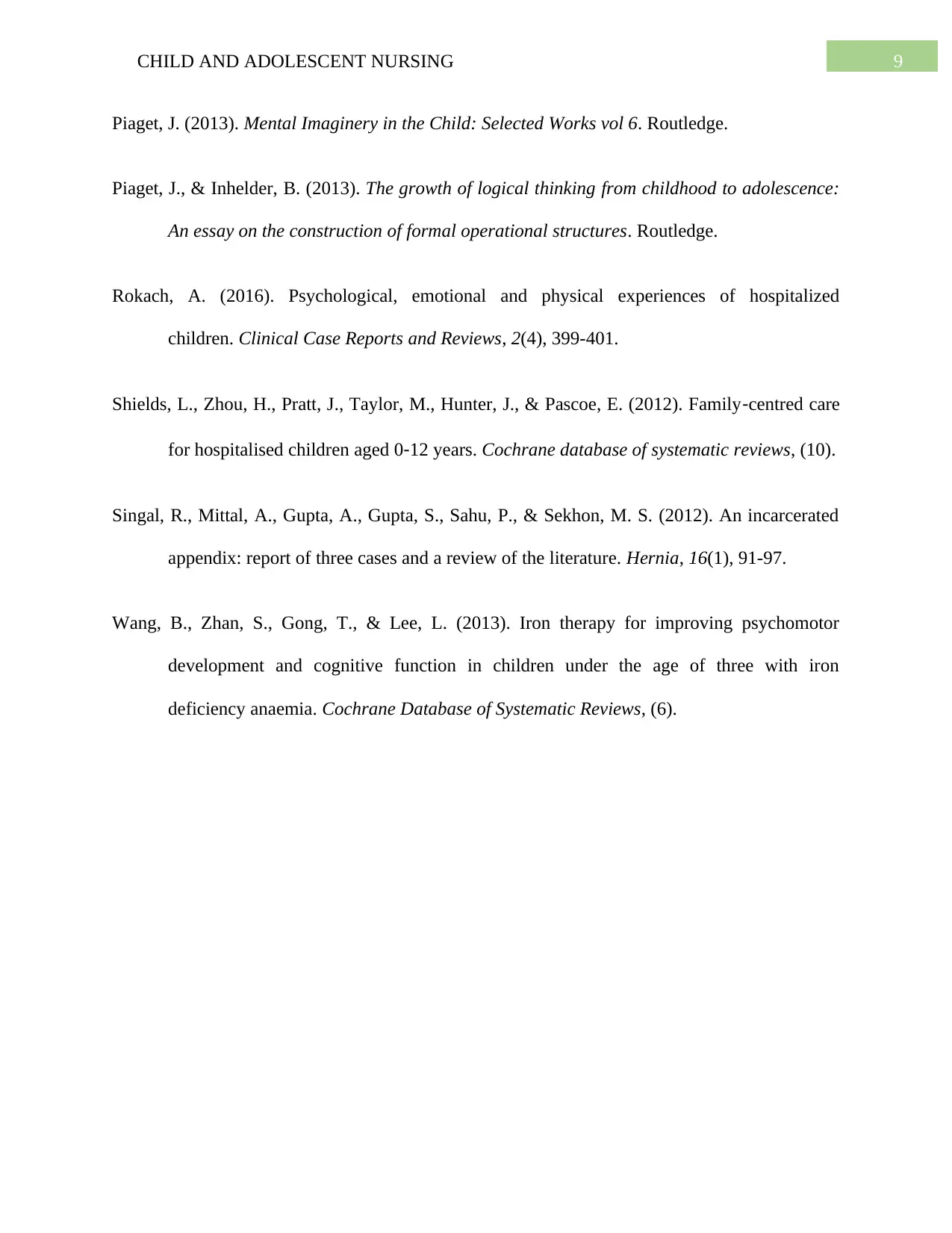
9CHILD AND ADOLESCENT NURSING
Piaget, J. (2013). Mental Imaginery in the Child: Selected Works vol 6. Routledge.
Piaget, J., & Inhelder, B. (2013). The growth of logical thinking from childhood to adolescence:
An essay on the construction of formal operational structures. Routledge.
Rokach, A. (2016). Psychological, emotional and physical experiences of hospitalized
children. Clinical Case Reports and Reviews, 2(4), 399-401.
Shields, L., Zhou, H., Pratt, J., Taylor, M., Hunter, J., & Pascoe, E. (2012). Family‐centred care
for hospitalised children aged 0‐12 years. Cochrane database of systematic reviews, (10).
Singal, R., Mittal, A., Gupta, A., Gupta, S., Sahu, P., & Sekhon, M. S. (2012). An incarcerated
appendix: report of three cases and a review of the literature. Hernia, 16(1), 91-97.
Wang, B., Zhan, S., Gong, T., & Lee, L. (2013). Iron therapy for improving psychomotor
development and cognitive function in children under the age of three with iron
deficiency anaemia. Cochrane Database of Systematic Reviews, (6).
Piaget, J. (2013). Mental Imaginery in the Child: Selected Works vol 6. Routledge.
Piaget, J., & Inhelder, B. (2013). The growth of logical thinking from childhood to adolescence:
An essay on the construction of formal operational structures. Routledge.
Rokach, A. (2016). Psychological, emotional and physical experiences of hospitalized
children. Clinical Case Reports and Reviews, 2(4), 399-401.
Shields, L., Zhou, H., Pratt, J., Taylor, M., Hunter, J., & Pascoe, E. (2012). Family‐centred care
for hospitalised children aged 0‐12 years. Cochrane database of systematic reviews, (10).
Singal, R., Mittal, A., Gupta, A., Gupta, S., Sahu, P., & Sekhon, M. S. (2012). An incarcerated
appendix: report of three cases and a review of the literature. Hernia, 16(1), 91-97.
Wang, B., Zhan, S., Gong, T., & Lee, L. (2013). Iron therapy for improving psychomotor
development and cognitive function in children under the age of three with iron
deficiency anaemia. Cochrane Database of Systematic Reviews, (6).
1 out of 10
Your All-in-One AI-Powered Toolkit for Academic Success.
+13062052269
info@desklib.com
Available 24*7 on WhatsApp / Email
![[object Object]](/_next/static/media/star-bottom.7253800d.svg)
Unlock your academic potential
© 2024 | Zucol Services PVT LTD | All rights reserved.





